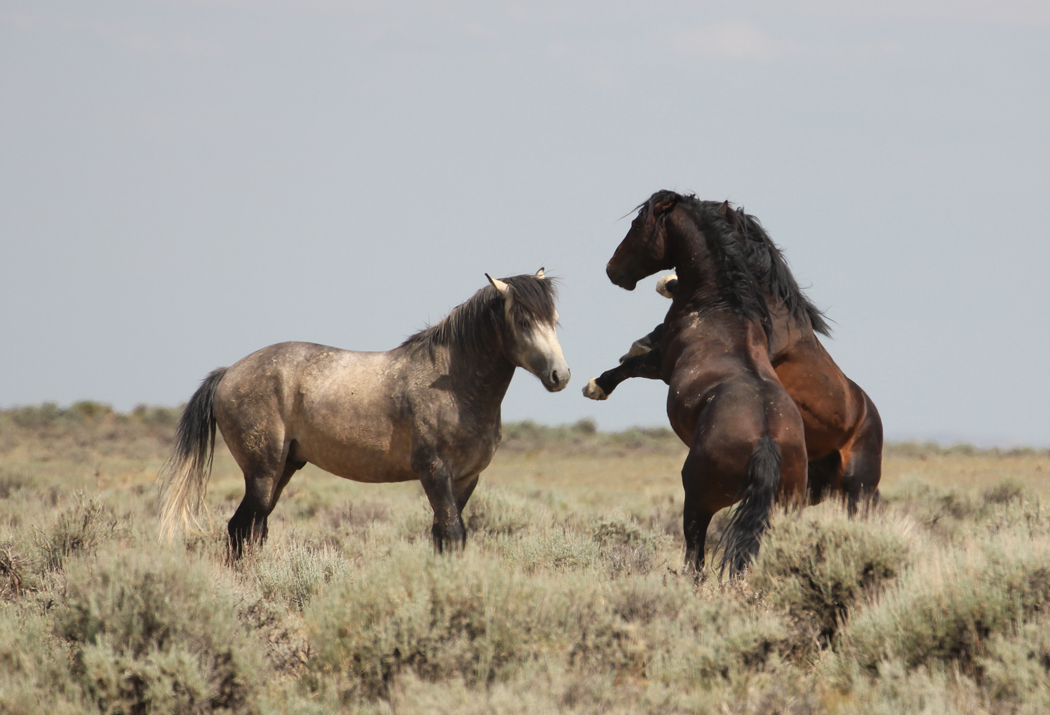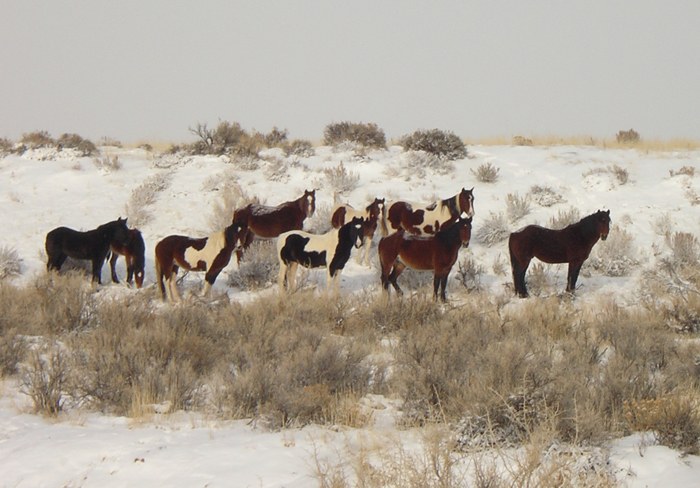This entry was contributed to Wild Equus by Dr. Jason Ransom of Colorado State University, member and specialist of the Wild Equus Network (WEN).
Species: Equus caballus
Subspecies/Breed/Type: American Mustang
Country: United States of America
Region/Province/Range: Park County – Wyoming
Population type: Semi feral-heavily managed
Estimated Population size: between 112-194 horses
Management Authority: Bureau of Land Management -McCullough Peaks HMA
Images by Jason Ransom. Please respect © copyright!
Management Practices:
The US Bureau of Land Management has managed this population with periodic round-ups, adopting removed horses to the public. Since 2004, management has more intensively been done using a time-released form of the immunocontraceptive PZP and periodic round-ups.
Details of Population
McCullough Peaks Herd Management Area is located Park County, Wyoming, USA (latitude 44°35‘N, longitude 108°40‘W), and consists of 44,400 ha of primarily open sagebrush steppe with badlands along the western edge. Vegetation consists of large expanses of small shrubs, grasses, and forbs. Pronghorn antelope and mule deer are sympatric with horses here and little natural depredation occurs. Elevations range from 1,200 m to 1,964 m. Mean annual temperature is 8.0°C (range -30.0– 37.8°C) and mean total annual precipitation is 271.2 mm (range=168.9–389.1 mm).
Structure and demographics
Population size reached a high of 495 horses before a large management removal in 2004, and now is maintained between 112 and 194 horses. Bands average 8 horses and many bands closely associate into herds; travelling, feeding, and resting together. At its largest population, bands with more than one stallion occurred, but are now infrequent. Bachelors form loosely associated ephemeral bands or range independently. Genetically, these horses are most related to draft breeds such as the Percheron, probably reflecting much of the early settlement activity around the old west town of Cody. Horses of all colors are in this herd, including Overo, Tobiano, and Sabino paint horses.
Issues worth noting and needed actions
Like most populations in the USA, available habitat for horses is finite and management is necessary to protect all natural resources while attempting to balance the multiple-use mandate for the federal lands where horses live. The science needed for more-informed management is improving, but many obstacles persist. You can read much more in the 2013 National Research Council report “Using Science to Improve the BLM Wild Horse and Burro Program: A Way Forward”
Bibliography and further reading
Additional details about this population, and specifically about behavior and fertility control, can be found in:
Ransom, J.I., Roelle, J.E., Cade, B.S., Coates-Markle, L., and A.J. Kane. 2011. Foaling rates in feral horses treated with the immunocontraceptive porcine zona pellucida. Wildlife Society Bulletin 35:343-352
Ransom, J.I., Cade, B.S., and N.T. Hobbs. 2010. Influences of immunocontraception on time budgets, social behavior, and body condition in feral horses. Applied Animal Behaviour Science 124:51-60
On-going behavior and ecology research from Dr. Ransom can be followed on Twitter @wildequids
If you have further information or images you would like to share please contact us by email.
More entries to the Wild Equus Atlas;
Venezuelan Creoles WE – Entry from Dr. Jose Luis Canelon
Pottoka Piornal ponies WE – Entry from Lucy Ress
Pryor Mountain wild horses WE – Entry from Dr. Jason Ransom
McCullough Peaks horses – Entry from Dr. Jason Ransom
Aveto horses (WE) – Entry from Evelina Isola
Galician wild ponies WE – Entry from Dr. Laura Lagos
Namibia Desert horses WE – Entry from Dr. Telané Greyling
Delft Island horses WE – Entry from Wild Equus
Little Book Cliffs Wild Horses WE – Entry from Dr. Jason Ransom
Gower ponies WE – Entry from Jennie Nellist
Baguales WE – Entry from Dr. Victor Moraga and Enrique Zunzunegui
Exmoor Ponies WE – Entry from Sue McGeever
Tornquist feral horses WE – Entry from Dr. Alberto Scorolli
Sabucedo horses WE – Entry from Ivan Sanmartin Eirin
Cumberland Island horses WE – Entry from Wild Equus
Feral horses of Cotopaxi WE – Entry from Javier Solis Méndez, Lucy Rees, Johanna Marlès and Juan Bermeo
Please share this initiative far and wide. Gracias!
This is an ongoing work, and as such, will be updated regularly as new information is made available.






Beautiful photos!